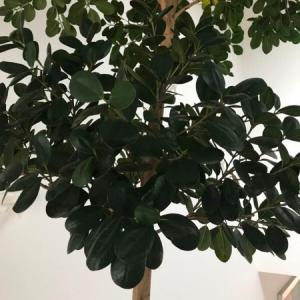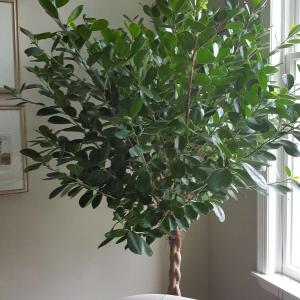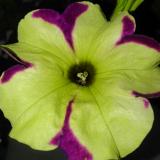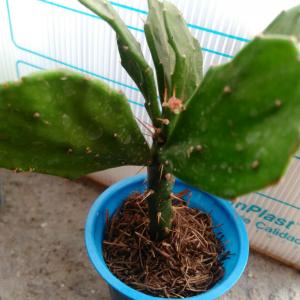文章
Dummer. ゛☀
2017年08月20日

Ficus plants are commonly sold as houseplants. One of the more striking due to its glossy leaves, is the rubber tree plant. These are fairly easy to care for but dislike being moved and are fussy about water. Rubber plant watering must provide matching moisture to what the plants would find in their native Southeast Asian habitat. However, in the home interior this may be difficult to achieve unless you are vigilant or use a plant moisture meter. Learn to know signs for when to water a rubber tree plant, so your Ficus is happy and healthy.
How Much Water Do Rubber Tree Plants Need?
Ficus are a large genus of tropical to semi-tropical plants, many of which are perfect for the home interior. The rubber plant produces a perfect home sized tree and is adaptable to indoor growing.
Water requirements for rubber plants are consistently moist but never soggy. Soggy plants can get root rot, soil gnats and other problems. Dry soil causes leaves to drop and reduces the overall health and growth of the plant. Getting rubber plant watering right will ensure beautiful leaves and maximum growth. Rubber plants are rainforest specimens. As such, they are adapted to plentiful water. But as with most plants, excess or standing water can be detrimental to their health. So how much water do rubber tree plants need?
The first step is to ensure the container the plant is in has adequate drainage holes. Also, make sure the potting medium has some peat, vermiculite or perlite in it. Peat holds water and air, increasing porosity. Vermiculite has the same purpose while a calcined clay perlite improves moisture and nutrient holding abilities of the soil medium. Use a dish under the plant that is lined with pebbles to catch excess moisture but keep the roots from sitting in water. This will evaporate gradually increasing humidity around the rubber tree. Never allow a container to sit in a saucer or dish without rocks. Roots sitting in soil will deteriorate and the plant will suffer.
When to Water a Rubber Tree Plant
The obvious answer is when the plant is dry but there is more to it than that. Even indoor plants respond to light and temperature changes. In winter, plants get less daylight and feel cold. They go into a sort of hibernation until more sunlight is available. Therefore, during winter you can cut watering in half. However, plants that are positioned near a fireplace or furnace will have their potting soil dry out much more quickly. In any case, if the top few inches of soil are dry, it is time to water. You may opt for a water meter or simply insert your finger into soil. Most water meters should read a 4 at optimum moisture levels. Rubber plants need to be checked weekly during the growing season. A good sign that you are overwatering is yellow leaves. At the first sign of yellowing, decrease watering slightly and healthy green, glossy leaves appear. Prior to watering, allow tap water to sit for a few hours to allow chlorine to evaporate and the water to come to room temperature. This causes less shock to the plant than icy water. When watering a rubber plant, drench the soil completely until excess moisture runs out the drainage holes. This will not only water the roots but leach out any built-up salts from fertilizing. Allow the top few inches of soil to dry out between each watering.

How Much Water Do Rubber Tree Plants Need?
Ficus are a large genus of tropical to semi-tropical plants, many of which are perfect for the home interior. The rubber plant produces a perfect home sized tree and is adaptable to indoor growing.
Water requirements for rubber plants are consistently moist but never soggy. Soggy plants can get root rot, soil gnats and other problems. Dry soil causes leaves to drop and reduces the overall health and growth of the plant. Getting rubber plant watering right will ensure beautiful leaves and maximum growth. Rubber plants are rainforest specimens. As such, they are adapted to plentiful water. But as with most plants, excess or standing water can be detrimental to their health. So how much water do rubber tree plants need?

The first step is to ensure the container the plant is in has adequate drainage holes. Also, make sure the potting medium has some peat, vermiculite or perlite in it. Peat holds water and air, increasing porosity. Vermiculite has the same purpose while a calcined clay perlite improves moisture and nutrient holding abilities of the soil medium. Use a dish under the plant that is lined with pebbles to catch excess moisture but keep the roots from sitting in water. This will evaporate gradually increasing humidity around the rubber tree. Never allow a container to sit in a saucer or dish without rocks. Roots sitting in soil will deteriorate and the plant will suffer.

When to Water a Rubber Tree Plant
The obvious answer is when the plant is dry but there is more to it than that. Even indoor plants respond to light and temperature changes. In winter, plants get less daylight and feel cold. They go into a sort of hibernation until more sunlight is available. Therefore, during winter you can cut watering in half. However, plants that are positioned near a fireplace or furnace will have their potting soil dry out much more quickly. In any case, if the top few inches of soil are dry, it is time to water. You may opt for a water meter or simply insert your finger into soil. Most water meters should read a 4 at optimum moisture levels. Rubber plants need to be checked weekly during the growing season. A good sign that you are overwatering is yellow leaves. At the first sign of yellowing, decrease watering slightly and healthy green, glossy leaves appear. Prior to watering, allow tap water to sit for a few hours to allow chlorine to evaporate and the water to come to room temperature. This causes less shock to the plant than icy water. When watering a rubber plant, drench the soil completely until excess moisture runs out the drainage holes. This will not only water the roots but leach out any built-up salts from fertilizing. Allow the top few inches of soil to dry out between each watering.
0
1
文章
Dummer. ゛☀
2017年08月20日

A rubber tree plant is also known as a Ficus elastica. These large trees can grow up to 50 feet tall. When learning how to care for a rubber tree plant, there are a few key things to remember, but rubber plant care isn’t as difficult as one might think. Starting with a young rubber tree houseplant will allow it to adapt to being an indoor plant better than starting with a more mature plant.
Proper Light and Water for a Rubber Tree Plant
When it comes to rubber plant care, the correct balance of water and light is crucial, as with any plant. You can control the amount of light and water it gets, which is important because they shouldn’t have too much of either.
Light
When you have a rubber tree houseplant, it needs bright light but prefers indirect light that isn’t too hot. Some people recommend putting it near a window that has sheer curtains. This allows plenty of light, but not too much.
Water
The rubber tree plant also needs the right balance of water. During the growing season, it needs to be kept moist. It is also a good idea to wipe off the leaves of your rubber tree houseplant with a damp cloth or spritz it with water. If you water the rubber tree plant too much, the leaves will turn yellow and brown and fall off. During the dormant season, it may only need watered once or twice a month. If the leaves begin to droop, but not fall off, increase the water you give the rubber tree houseplant gradually until the leaves perk back up again.
Propagation of a Rubber Tree Plant
Once you know how to care for a rubber tree plant and it is growing well, you can begin the propagation of indoor rubber tree plants. In order to promote new leaves on a current rubber tree houseplant, cut a slit in the node where a leaf fell off. This will allow a new leaf to grow quicker. There are a couple different methods for creating new rubber tree plant cuttings. The simplest is to take a small branch from a healthy tree and put it in good potting soil or water and let it root. Another method, called air layering, is where you make a cut in a healthy rubber tree houseplant, put a toothpick in the hole, then pack damp moss around the cut. After that, you wrap it with plastic wrap to keep the moisture level higher. Once roots begin to appear, cut the branch off and plant. All these things will lead to successful rubber plant care.

Proper Light and Water for a Rubber Tree Plant
When it comes to rubber plant care, the correct balance of water and light is crucial, as with any plant. You can control the amount of light and water it gets, which is important because they shouldn’t have too much of either.
Light
When you have a rubber tree houseplant, it needs bright light but prefers indirect light that isn’t too hot. Some people recommend putting it near a window that has sheer curtains. This allows plenty of light, but not too much.

Water
The rubber tree plant also needs the right balance of water. During the growing season, it needs to be kept moist. It is also a good idea to wipe off the leaves of your rubber tree houseplant with a damp cloth or spritz it with water. If you water the rubber tree plant too much, the leaves will turn yellow and brown and fall off. During the dormant season, it may only need watered once or twice a month. If the leaves begin to droop, but not fall off, increase the water you give the rubber tree houseplant gradually until the leaves perk back up again.

Propagation of a Rubber Tree Plant
Once you know how to care for a rubber tree plant and it is growing well, you can begin the propagation of indoor rubber tree plants. In order to promote new leaves on a current rubber tree houseplant, cut a slit in the node where a leaf fell off. This will allow a new leaf to grow quicker. There are a couple different methods for creating new rubber tree plant cuttings. The simplest is to take a small branch from a healthy tree and put it in good potting soil or water and let it root. Another method, called air layering, is where you make a cut in a healthy rubber tree houseplant, put a toothpick in the hole, then pack damp moss around the cut. After that, you wrap it with plastic wrap to keep the moisture level higher. Once roots begin to appear, cut the branch off and plant. All these things will lead to successful rubber plant care.
1
1
文章
Dummer. ゛☀
2017年08月12日

Ficus trees are a popular houseplant that can be found in many homes, but the attractive and easy to care for ficus trees still have a frustrating habit of dropping leaves, seemingly without reason. This leaves many ficus owners asking, “Why is my ficus losing leaves?” The causes for dropping ficus leaves are many, but when you know what they are, this can help you pin down the reason your ficus tree leaves are falling off.
Reasons for Ficus Tree Dropping Leaves
First of all, realize that it is normal for a ficus tree to lose some leaves. A few leaves dropping of a ficus tree will not hurt it and they will regrow, but if your ficus is losing more than a few leaves, the following reasons could be why:
Change in environment – The most common cause for dropping ficus leaves is that its environment has changed. Often, you will see ficus leaves drop when the seasons change. The humidity and temperature in your house also changes at this time and this can cause ficus trees to lose leaves. If this is affecting your tree, the leaves on the ficus tree may be yellow in addition to falling off. To help with this, try to keep your ficus tree’s environment as stable as possible. Keep it away from drafty windows and doors, air conditioners and heaters. Use a humidifier in the winter, when the air gets dry. And, once you have placed your ficus tree in your home, do not move it.
Incorrect watering – Under watering or over watering both can cause a ficus tree to lose leaves. In an improperly watered ficus tree may have yellowing leaves and the ficus tree leaves may curl. Water the soil only when the very top of the soil is dry, but also make sure that your ficus tree’s pot has good drainage. If you accidentally let your ficus tree’s soil dry out completely, you may need to soak the tree’s container in the tub for an hour to properly rehydrate the soil. If you have overwatered, root rot may have set in and you will need to treat the ficus tree for that.
Too little light – Another reason for ficus tree leaves falling off is that the tree is getting too little light. Often, a ficus tree that is getting too little light will look sparse and spindly. New leaves may also appear pale or even white. In this case, you should move the ficus tree to a location where it will get more light. Pests – Ficus trees are susceptible to a few pests that can cause a ficus tree to drop leaves. Often, a sure sign of a pest problem will be that the leaves on the ficus tree will be sticky or have liquid dripping off them as well as falling off. If this is the problem, you will need to treat the plant with insecticide like neem oil.
Fungus – Ficus trees are also occasionally affected by fungus, which can make the tree drop its leaves. Often, a ficus tree with a fungus will have yellow or brown spots on the leaves. To correct treat this reason for ficus tree leaves falling off, use fungicide (like neem oil) on the tree.

Reasons for Ficus Tree Dropping Leaves
First of all, realize that it is normal for a ficus tree to lose some leaves. A few leaves dropping of a ficus tree will not hurt it and they will regrow, but if your ficus is losing more than a few leaves, the following reasons could be why:
Change in environment – The most common cause for dropping ficus leaves is that its environment has changed. Often, you will see ficus leaves drop when the seasons change. The humidity and temperature in your house also changes at this time and this can cause ficus trees to lose leaves. If this is affecting your tree, the leaves on the ficus tree may be yellow in addition to falling off. To help with this, try to keep your ficus tree’s environment as stable as possible. Keep it away from drafty windows and doors, air conditioners and heaters. Use a humidifier in the winter, when the air gets dry. And, once you have placed your ficus tree in your home, do not move it.
Incorrect watering – Under watering or over watering both can cause a ficus tree to lose leaves. In an improperly watered ficus tree may have yellowing leaves and the ficus tree leaves may curl. Water the soil only when the very top of the soil is dry, but also make sure that your ficus tree’s pot has good drainage. If you accidentally let your ficus tree’s soil dry out completely, you may need to soak the tree’s container in the tub for an hour to properly rehydrate the soil. If you have overwatered, root rot may have set in and you will need to treat the ficus tree for that.

Too little light – Another reason for ficus tree leaves falling off is that the tree is getting too little light. Often, a ficus tree that is getting too little light will look sparse and spindly. New leaves may also appear pale or even white. In this case, you should move the ficus tree to a location where it will get more light. Pests – Ficus trees are susceptible to a few pests that can cause a ficus tree to drop leaves. Often, a sure sign of a pest problem will be that the leaves on the ficus tree will be sticky or have liquid dripping off them as well as falling off. If this is the problem, you will need to treat the plant with insecticide like neem oil.

Fungus – Ficus trees are also occasionally affected by fungus, which can make the tree drop its leaves. Often, a ficus tree with a fungus will have yellow or brown spots on the leaves. To correct treat this reason for ficus tree leaves falling off, use fungicide (like neem oil) on the tree.
0
0
文章
Dummer. ゛☀
2017年08月12日

Ficus are one of the most common and easy to grow houseplants. In fact, they are so easy to grow indoors that occasionally the plants outgrow their site. Ficus plants don’t like to be moved, so the best option is to prune the plant to keep it manageable. Let’s talk about how to prune a ficus tree and, more importantly for the plant’s health, when should ficus be pruned? Ficus are not winter hardy and are generally grown as houseplants in the United States and other parts of the world. They are native to tropical and subtropical regions and are considered part of this type of exterior landscaping in warm zones. Indoor plants have slow, steady growth but can become heavy on the ends and lose their arching shape. Rejuvenation pruning will make the plant more compact and enhance proper branch formation.
When Should Ficus Be Pruned?
Obviously, trimming ficus trees is necessary if the plant has grown into a byway or is touching the ceiling. Trimming to diminish size is a common reason for pruning any woody plant. Timing is also an issue. Ficus tree pruning needs to take place when the plant is no longer actively growing. Most plants are vegetatively active in spring and summer, with growth dying down in fall. By winter, the plant has gone into dormancy and is less susceptible to injury. Therefore, winter is the best time for trimming ficus trees. You can prune out dead material at any time during the year.
How to Prune a Ficus Tree
Use a clean sharp pair of bypass pruners and don a pair of gloves. Ficus have a latex sap that may be irritating to skin. First, look at the tree overall and decide what areas need to be minimized. If the tree is too tall, this is clearly where you start, but if you need to create a better silhouette, you will have to make a plan before you start cutting. There are some cutting rules for ficus tree pruning in order to create a better appearance and keep cuts from looking obvious. Once you have decided which vegetation needs to go, the first step is to remove any dead or broken branches. This will give you an even better idea of the remaining necessary cuts.
Ficus Pruning Tips
Cut just before a growth node so that new growth will sprout there and cover the stump. Another tip is to remove a branch back to another branch that is one of its size. This will prevent unsightly stubs and restore the size and appearance of the ficus. Cut at a slant away from the node or secondary branch. If you have a damaged ficus with lots of dead growth, prune away no more than one-third of the material. You can cut more off later as the plant recovers. The best time to try this sort of pruning is after the plant has started re-sprouting so you can ensure that you are not removing recovered material.

When Should Ficus Be Pruned?
Obviously, trimming ficus trees is necessary if the plant has grown into a byway or is touching the ceiling. Trimming to diminish size is a common reason for pruning any woody plant. Timing is also an issue. Ficus tree pruning needs to take place when the plant is no longer actively growing. Most plants are vegetatively active in spring and summer, with growth dying down in fall. By winter, the plant has gone into dormancy and is less susceptible to injury. Therefore, winter is the best time for trimming ficus trees. You can prune out dead material at any time during the year.

How to Prune a Ficus Tree
Use a clean sharp pair of bypass pruners and don a pair of gloves. Ficus have a latex sap that may be irritating to skin. First, look at the tree overall and decide what areas need to be minimized. If the tree is too tall, this is clearly where you start, but if you need to create a better silhouette, you will have to make a plan before you start cutting. There are some cutting rules for ficus tree pruning in order to create a better appearance and keep cuts from looking obvious. Once you have decided which vegetation needs to go, the first step is to remove any dead or broken branches. This will give you an even better idea of the remaining necessary cuts.

Ficus Pruning Tips
Cut just before a growth node so that new growth will sprout there and cover the stump. Another tip is to remove a branch back to another branch that is one of its size. This will prevent unsightly stubs and restore the size and appearance of the ficus. Cut at a slant away from the node or secondary branch. If you have a damaged ficus with lots of dead growth, prune away no more than one-third of the material. You can cut more off later as the plant recovers. The best time to try this sort of pruning is after the plant has started re-sprouting so you can ensure that you are not removing recovered material.
0
0
文章
Dummer. ゛☀
2017年08月12日

Weeping figs (Ficus benjamina) are elegant trees with slender gray trunks and a profusion of green leaves. Weeping fig tree care depends on whether you are growing weeping fig trees indoors or outdoors. Let’s learn more about outdoor care for weeping figs.
Weeping Fig Plant Information
Growing weeping fig trees indoors and growing weeping fig trees outdoors are completely different endeavors. It is almost as if indoor and outdoor weeping figs are different species.
Indoors, weeping figs are attractive container plants that rarely grow above 6 to 8 feet. Outdoors, however, the trees grow into huge specimens (up to 100 feet tall and 50 feet wide) and are often used for hedges. That being said, weeping figs only thrive outdoors in USDA plant hardiness zones 10 to 11. Therefore, most weeping figs are grown as indoor plants. If you are fortunate enough to live in one of these warm, tropical-like areas though, caring for weeping figs outdoors is something you need to know.
Weeping Fig Tree Care Outdoors
As indoor container plants, weeping figs grow quite slowly, but outside, it’s a different story. This plant can quickly become a monster of a tree if not kept pruned, which it tolerates well. In fact, with regards to weeping fig tree pruning, it readily accepts severe pruning, so don’t hesitate to remove any dead foliage when you see it. If you want to do weeping fig tree pruning to shape or reduce the size of the tree, you can take off up to one-third of the outer growth of the canopy at a time. Caring for weeping figs indoors is a matter of selecting an appropriate location. As its roots spread just as fast as it grows tall, the tree can potentially damage foundations. So, if choosing to grow outdoors, plant it well away from the home, at least 30 feet. If you read up on weeping fig plant information, you find that the plant prefers well-drained, moist, loamy soil and thrives in a location with bright, indirect sunlight indoors. Outdoors is pretty much the same with a few exceptions. The tree can grow well in full sun to shade.
Once established, creeping figs are fairly drought and heat tolerant. They are said to be hardy to 30 F. (-1 C.) but just one hard frost can cause severe damage to the tree. However, when grown in areas with less harsh winters, most will rebound provided the roots are protected. Adding a 3- to 4-inch layer of mulch can help. Outdoor problems with creeping figs include freezing temps; severe drought; high winds; and insect pests, especially thrips. Weeping fig tree care can be tricky since issues are often hard to diagnose. No matter what the problem, the tree reacts the same way: it drops leaves. Most experts agree that the number one cause of leaf drop in weeping fig is overwatering (especially indoors). A good rule of thumb is to keep your tree’s soil moist but never wet, backing off in the winter. You can provide the tree with liquid fertilizer about once a month during the growing season, but outdoors this isn’t usually necessary or advisable due to its faster growth.

Weeping Fig Plant Information
Growing weeping fig trees indoors and growing weeping fig trees outdoors are completely different endeavors. It is almost as if indoor and outdoor weeping figs are different species.
Indoors, weeping figs are attractive container plants that rarely grow above 6 to 8 feet. Outdoors, however, the trees grow into huge specimens (up to 100 feet tall and 50 feet wide) and are often used for hedges. That being said, weeping figs only thrive outdoors in USDA plant hardiness zones 10 to 11. Therefore, most weeping figs are grown as indoor plants. If you are fortunate enough to live in one of these warm, tropical-like areas though, caring for weeping figs outdoors is something you need to know.

Weeping Fig Tree Care Outdoors
As indoor container plants, weeping figs grow quite slowly, but outside, it’s a different story. This plant can quickly become a monster of a tree if not kept pruned, which it tolerates well. In fact, with regards to weeping fig tree pruning, it readily accepts severe pruning, so don’t hesitate to remove any dead foliage when you see it. If you want to do weeping fig tree pruning to shape or reduce the size of the tree, you can take off up to one-third of the outer growth of the canopy at a time. Caring for weeping figs indoors is a matter of selecting an appropriate location. As its roots spread just as fast as it grows tall, the tree can potentially damage foundations. So, if choosing to grow outdoors, plant it well away from the home, at least 30 feet. If you read up on weeping fig plant information, you find that the plant prefers well-drained, moist, loamy soil and thrives in a location with bright, indirect sunlight indoors. Outdoors is pretty much the same with a few exceptions. The tree can grow well in full sun to shade.

Once established, creeping figs are fairly drought and heat tolerant. They are said to be hardy to 30 F. (-1 C.) but just one hard frost can cause severe damage to the tree. However, when grown in areas with less harsh winters, most will rebound provided the roots are protected. Adding a 3- to 4-inch layer of mulch can help. Outdoor problems with creeping figs include freezing temps; severe drought; high winds; and insect pests, especially thrips. Weeping fig tree care can be tricky since issues are often hard to diagnose. No matter what the problem, the tree reacts the same way: it drops leaves. Most experts agree that the number one cause of leaf drop in weeping fig is overwatering (especially indoors). A good rule of thumb is to keep your tree’s soil moist but never wet, backing off in the winter. You can provide the tree with liquid fertilizer about once a month during the growing season, but outdoors this isn’t usually necessary or advisable due to its faster growth.
0
0
文章
Dummer. ゛☀
2017年08月12日

If you’ve ever watched your favorite weeping fig drop its leaves like tears when the light changed a little, you may be ready to try banana leaf ficus tree (Ficus maclellandii sometimes labeled as F. binnendijkii). Banana leaf fig is much less temperamental than its cousin ficus species, and adapts more readily to changing illumination in your home. Read on for information about growing banana leaf ficus.
Ficus Banana Leaf Plants
Ficus is the Latin word for fig, and is also the genus name of about 800 fig species. Figs are woody trees, shrubs, or vines native to Asia, Australia, and Africa. Those species cultivated for home gardens or backyards either produce edible fruit or are grown for their ornamental value. Banana leaf ficus trees are shrubs or small trees with long, saber-shaped leaves. The leaves emerge red, but later turn dark green and become leathery. They droop gracefully from the tree, adding an exotic or tropical look to your home. Ficus banana leaf plants can be grown with one stem, multiple stems or even braided stems. The crown is open and irregular.
Growing Banana Leaf Ficus
Like the weeping fig, the banana leaf ficus tree grows into a small tree, up to 12 feet tall, and is usually grown as a houseplant. As a tropical fig, it can only grow outdoors in U.S. Department of Agriculture plant hardiness zone 11. Growing banana leaf ficus plants successfully is mostly a matter of finding the correct location for the shrub. The banana leaf fig needs an indoor location with bright filtered light that is protected from drafts. Use well-drained soilless potting mix for growing banana leaf ficus plants. When it comes to banana leaf ficus care, your temptation may be to overwater the tree. However, you must resist. Keep the soil slightly moist and avoid overwatering. If you apply an inch of organic mulch, like wood chips, it helps keep that moisture in. Fertilizer is a part of banana leaf ficus care. Feed your ficus banana leaf plant with a general, water soluble fertilizer every other month in spring, summer and fall. Do not fertilize the plant in winter. You can prune the plant a little if you think it is necessary to shape it.

Ficus Banana Leaf Plants
Ficus is the Latin word for fig, and is also the genus name of about 800 fig species. Figs are woody trees, shrubs, or vines native to Asia, Australia, and Africa. Those species cultivated for home gardens or backyards either produce edible fruit or are grown for their ornamental value. Banana leaf ficus trees are shrubs or small trees with long, saber-shaped leaves. The leaves emerge red, but later turn dark green and become leathery. They droop gracefully from the tree, adding an exotic or tropical look to your home. Ficus banana leaf plants can be grown with one stem, multiple stems or even braided stems. The crown is open and irregular.

Growing Banana Leaf Ficus
Like the weeping fig, the banana leaf ficus tree grows into a small tree, up to 12 feet tall, and is usually grown as a houseplant. As a tropical fig, it can only grow outdoors in U.S. Department of Agriculture plant hardiness zone 11. Growing banana leaf ficus plants successfully is mostly a matter of finding the correct location for the shrub. The banana leaf fig needs an indoor location with bright filtered light that is protected from drafts. Use well-drained soilless potting mix for growing banana leaf ficus plants. When it comes to banana leaf ficus care, your temptation may be to overwater the tree. However, you must resist. Keep the soil slightly moist and avoid overwatering. If you apply an inch of organic mulch, like wood chips, it helps keep that moisture in. Fertilizer is a part of banana leaf ficus care. Feed your ficus banana leaf plant with a general, water soluble fertilizer every other month in spring, summer and fall. Do not fertilize the plant in winter. You can prune the plant a little if you think it is necessary to shape it.

0
0
文章
Dummer. ゛☀
2017年08月12日

Ficus trees are a common plant in the home and office, mainly because they look like a typical tree with a single trunk and a spreading canopy. But for all of their popularity, ficus plants are finicky. However, if you know how to care for a ficus tree, you’ll be better equipped with keeping it healthy and happy in your home for years.
Learn About Ficus Houseplants
What is commonly referred to as a ficus is technically a weeping fig. It’s a member of the Ficus genus of plants, which also includes rubber trees and fig fruit trees, but when it comes to houseplants, most people refer to a weeping fig (Ficus benjamina) as simply a ficus. Ficus trees can maintain their tree-like shape regardless of their size, so this makes them ideal for bonsais or for massive houseplants in large spaces. Their leaves can be either dark green or variegated. In recent years, some imaginative nurseries have started to take advantage of their pliable trunks to braid or twist the plants into different forms.
Growing Ficus Indoors
Most ficus trees enjoy bright indirect or filtered light with variegated varieties happily able to take medium light. Bright, direct light may result in scalding of the leaves and leaf loss. Ficus trees also cannot tolerate low temperatures or drafts. They need to be kept in temperatures above 60 F. (16 C.) and actually prefer temperatures above 70 F. (21 C.). Cold drafts from windows or doors will harm them, so make sure to place them somewhere where drafts will not be an issue.
How to Care for a Ficus Tree
When growing ficus indoors, it’s important to maintain a relatively high humidity around the plant. Regular misting or setting the ficus tree on a pebble tray filled with water is a great way to increase their humidity, but keep in mind that while they like high humidity, they don’t like overly wet roots. Therefore, when watering, always check the top of the soil first. If the top of the soil is wet, don’t water as this means they have enough moisture. If the top of the soil feels dry to the touch, this indicates that they need water. Also while caring for a ficus plant, be aware that they are rapid growers and require plenty of nutrients to grow well. Fertilize once a month in the spring and summer and once every two months in the fall and winter.
Common Problems When Caring for a Ficus Plant
Almost everyone who has owned a ficus tree has asked themselves at some point, “Why is my ficus tree dropping its leaves?” A ficus tree losing its leaves is the most common problem these plants have. Leaf drop is a ficus tree’s standard reaction to stress, whether it’s from any of the following: Under watering or over watering Low humidity Too little light Relocation or repotting Drafts Change in temperature (too hot or cold) Pests If your ficus is losing its leaves, go through the checklist of proper ficus tree care and correct anything that you find wrong. Ficus are also prone to pests such as mealybugs, scale and spider mites. A healthy ficus tree will not see these problems, but a stressed ficus tree (likely losing leaves) will surely develop a pest problem quickly. “Sap” dripping from a ficus houseplant, which is actually honeydew from an invading pest, is a sure sign of an infestation. Treating the plant with neem oil is a good way to handle any of these pest issues.

Learn About Ficus Houseplants
What is commonly referred to as a ficus is technically a weeping fig. It’s a member of the Ficus genus of plants, which also includes rubber trees and fig fruit trees, but when it comes to houseplants, most people refer to a weeping fig (Ficus benjamina) as simply a ficus. Ficus trees can maintain their tree-like shape regardless of their size, so this makes them ideal for bonsais or for massive houseplants in large spaces. Their leaves can be either dark green or variegated. In recent years, some imaginative nurseries have started to take advantage of their pliable trunks to braid or twist the plants into different forms.

Growing Ficus Indoors
Most ficus trees enjoy bright indirect or filtered light with variegated varieties happily able to take medium light. Bright, direct light may result in scalding of the leaves and leaf loss. Ficus trees also cannot tolerate low temperatures or drafts. They need to be kept in temperatures above 60 F. (16 C.) and actually prefer temperatures above 70 F. (21 C.). Cold drafts from windows or doors will harm them, so make sure to place them somewhere where drafts will not be an issue.

How to Care for a Ficus Tree
When growing ficus indoors, it’s important to maintain a relatively high humidity around the plant. Regular misting or setting the ficus tree on a pebble tray filled with water is a great way to increase their humidity, but keep in mind that while they like high humidity, they don’t like overly wet roots. Therefore, when watering, always check the top of the soil first. If the top of the soil is wet, don’t water as this means they have enough moisture. If the top of the soil feels dry to the touch, this indicates that they need water. Also while caring for a ficus plant, be aware that they are rapid growers and require plenty of nutrients to grow well. Fertilize once a month in the spring and summer and once every two months in the fall and winter.
Common Problems When Caring for a Ficus Plant
Almost everyone who has owned a ficus tree has asked themselves at some point, “Why is my ficus tree dropping its leaves?” A ficus tree losing its leaves is the most common problem these plants have. Leaf drop is a ficus tree’s standard reaction to stress, whether it’s from any of the following: Under watering or over watering Low humidity Too little light Relocation or repotting Drafts Change in temperature (too hot or cold) Pests If your ficus is losing its leaves, go through the checklist of proper ficus tree care and correct anything that you find wrong. Ficus are also prone to pests such as mealybugs, scale and spider mites. A healthy ficus tree will not see these problems, but a stressed ficus tree (likely losing leaves) will surely develop a pest problem quickly. “Sap” dripping from a ficus houseplant, which is actually honeydew from an invading pest, is a sure sign of an infestation. Treating the plant with neem oil is a good way to handle any of these pest issues.
0
0
文章
Dummer. ゛☀
2017年08月06日

BOTANICAL NAME: Ficus
PLANT TYPE: Fruit
SUN EXPOSURE: Full SunPart Sun
SOIL TYPE: Any
BLOOM TIME: Spring
Figs thrive in areas with long and hot summers, though they can also be grown in containers. Figs can be eaten fresh from the tree, preserved, or used in cooking.
PLANTING
The common fig tree is the best choice to plant because its flowers are all female, meaning that they are self-pollinating and do not need to cross-pollinate with another tree to create fruit.
For container fig trees, grow them in soil-based potting mix and add fine bark chips. Keep the tree in full or filtered light. Be sure to add a high-nitrogen fertilizer every 4 weeks and water the tree moderately. It is important to keep the tree moist during the winter.
For outdoor fig trees, plant the tree in the spring in full or partial sun. Fig trees can grow in any type of soil as long as the soil is well-drained and contains plenty of organic material.
For container-grown trees, remove the plant from its pot and remove any circling roots by laying the root ball on its side and using shears to cut through the roots.
Dig a hole that is a few inches deeper and wider than the spread of the roots. Set the tree on top of a small mound of soil in the middle of the hole. Be sure to spread the roots away from the trunk without excessively bending them.
Plant the tree 2 to 4 inches deeper than it was originally in the pot (check the color of the trunk to see the original soil line).
Space the tree about 20 feet away from any buildings or other trees.
CARE
Be sure to water the young fig trees regularly to help them become established. In areas with dry climates, water fig trees deeply at least once a week.
Unless grown in containers, most fig trees do not require regular fertilization. However, if your fig tree is not growing much (less than 12 inches in one growing season), you can add ½ to 1 pound of nitrogen. Divide up the nitrogen into 3 to 4 feedings. Start applying the nitrogen in late winter and end in midsummer.
You can also apply a layer of mulch around the tree to help prevent weeds and keep in moisture for the roots.
Fig trees require little pruning. During the dormant season, be sure to remove all dead, diseased, or weak branches to encourage growth.
If you have an abundant growth of figs, you can thin the fruit to encourage larger figs.
PESTS/DISEASES
Nematodes
Leaf spots
Rust
Thrips
Twig dieback
PLANT TYPE: Fruit
SUN EXPOSURE: Full SunPart Sun
SOIL TYPE: Any
BLOOM TIME: Spring
Figs thrive in areas with long and hot summers, though they can also be grown in containers. Figs can be eaten fresh from the tree, preserved, or used in cooking.

PLANTING
The common fig tree is the best choice to plant because its flowers are all female, meaning that they are self-pollinating and do not need to cross-pollinate with another tree to create fruit.
For container fig trees, grow them in soil-based potting mix and add fine bark chips. Keep the tree in full or filtered light. Be sure to add a high-nitrogen fertilizer every 4 weeks and water the tree moderately. It is important to keep the tree moist during the winter.
For outdoor fig trees, plant the tree in the spring in full or partial sun. Fig trees can grow in any type of soil as long as the soil is well-drained and contains plenty of organic material.
For container-grown trees, remove the plant from its pot and remove any circling roots by laying the root ball on its side and using shears to cut through the roots.
Dig a hole that is a few inches deeper and wider than the spread of the roots. Set the tree on top of a small mound of soil in the middle of the hole. Be sure to spread the roots away from the trunk without excessively bending them.
Plant the tree 2 to 4 inches deeper than it was originally in the pot (check the color of the trunk to see the original soil line).
Space the tree about 20 feet away from any buildings or other trees.

CARE
Be sure to water the young fig trees regularly to help them become established. In areas with dry climates, water fig trees deeply at least once a week.
Unless grown in containers, most fig trees do not require regular fertilization. However, if your fig tree is not growing much (less than 12 inches in one growing season), you can add ½ to 1 pound of nitrogen. Divide up the nitrogen into 3 to 4 feedings. Start applying the nitrogen in late winter and end in midsummer.
You can also apply a layer of mulch around the tree to help prevent weeds and keep in moisture for the roots.
Fig trees require little pruning. During the dormant season, be sure to remove all dead, diseased, or weak branches to encourage growth.
If you have an abundant growth of figs, you can thin the fruit to encourage larger figs.

PESTS/DISEASES
Nematodes
Leaf spots
Rust
Thrips
Twig dieback
0
0
文章
玲儿
2017年07月06日

インドゴムノキの基本情報
学名:Ficus elastica
和名:インドゴムノキ その他の名前:ゴムノキ、フィカス・エラスティカ、フィカス‘デコラ’
科名 / 属名:クワ科 / イチジク属(フィクス属)
特徴
インドゴムノキは、自生地では高さ30mになる高木です。葉は厚く楕円形、長さ30cmで光沢のある濃緑色です。葉が斑入りの品種も多く、ミニ観葉から大鉢まで、年間楽しめます。
代表的な品種の‘デコラ’(Ficus elastica ‘Decora’)は、葉が厚くて広く、新葉を包む苞葉は赤みを帯びています。‘デコラ・バリエガタ’(F. elastica ‘Decora Variegata’)は、葉に黄色や黄緑色の斑がモザイク状に入ります。‘デコラ・トリカラー’(F. elastica ‘Decora Tricolor’)は葉縁に白色の斑が大きく入ります。よく似た品種で流通しているものに‘ティネケ’(F. elastica ‘Tineke’)や‘シルヴィー’(F. elastica ‘Silvie’)などがあります。‘アポロ’(F. elastica ‘Apollo’)は葉がやや小型、葉縁が波打って葉面の凹凸が目立ちます。‘バーガンディー’(F. elastica ‘Burgandy’)は‘アビジャン’(F. elastica ‘Abidjan’)とも呼ばれ、葉は光沢のある赤黒色となります。
いずれも栽培容易で、観葉植物のなかでは比較的寒さに強く、暖地では戸外で冬を越すことができます。

インドゴムノキの種類(原種、品種)
主な原種、園芸品種、仲間
‘デコラ・トリカラー’
Ficus elastic ‘Decora Tricolor’
緑色地の葉の外側に淡緑色の掃込み斑が入り、葉縁に乳白色の覆輪斑が入る品種。

‘アポロ’
Ficus elastic ‘Apollo’
葉は節間が短くてやや小形、表面は凹凸が目立つ品種。

‘バーガンディー’
Ficus elastica ‘Burgundy’
苞葉は濃赤色で、葉は紫褐色となる品種。

‘アサヒ’
Ficus elastica ‘Asahi’
葉は淡緑色地に乳白色の覆輪斑が入る品種。

‘ロブスタ’
Ficus elastica ‘Robusta’
葉は濃緑色で、節間が短く、葉が斜上する立ち葉となる品種。
学名:Ficus elastica
和名:インドゴムノキ その他の名前:ゴムノキ、フィカス・エラスティカ、フィカス‘デコラ’
科名 / 属名:クワ科 / イチジク属(フィクス属)
特徴
インドゴムノキは、自生地では高さ30mになる高木です。葉は厚く楕円形、長さ30cmで光沢のある濃緑色です。葉が斑入りの品種も多く、ミニ観葉から大鉢まで、年間楽しめます。
代表的な品種の‘デコラ’(Ficus elastica ‘Decora’)は、葉が厚くて広く、新葉を包む苞葉は赤みを帯びています。‘デコラ・バリエガタ’(F. elastica ‘Decora Variegata’)は、葉に黄色や黄緑色の斑がモザイク状に入ります。‘デコラ・トリカラー’(F. elastica ‘Decora Tricolor’)は葉縁に白色の斑が大きく入ります。よく似た品種で流通しているものに‘ティネケ’(F. elastica ‘Tineke’)や‘シルヴィー’(F. elastica ‘Silvie’)などがあります。‘アポロ’(F. elastica ‘Apollo’)は葉がやや小型、葉縁が波打って葉面の凹凸が目立ちます。‘バーガンディー’(F. elastica ‘Burgandy’)は‘アビジャン’(F. elastica ‘Abidjan’)とも呼ばれ、葉は光沢のある赤黒色となります。
いずれも栽培容易で、観葉植物のなかでは比較的寒さに強く、暖地では戸外で冬を越すことができます。

インドゴムノキの種類(原種、品種)
主な原種、園芸品種、仲間
‘デコラ・トリカラー’
Ficus elastic ‘Decora Tricolor’
緑色地の葉の外側に淡緑色の掃込み斑が入り、葉縁に乳白色の覆輪斑が入る品種。

‘アポロ’
Ficus elastic ‘Apollo’
葉は節間が短くてやや小形、表面は凹凸が目立つ品種。

‘バーガンディー’
Ficus elastica ‘Burgundy’
苞葉は濃赤色で、葉は紫褐色となる品種。

‘アサヒ’
Ficus elastica ‘Asahi’
葉は淡緑色地に乳白色の覆輪斑が入る品種。

‘ロブスタ’
Ficus elastica ‘Robusta’
葉は濃緑色で、節間が短く、葉が斜上する立ち葉となる品種。
0
0















